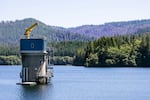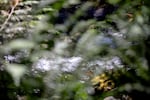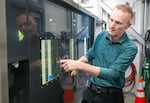During a warm August night last year, a lightning storm hovered over the Mount Hood National Forest long enough to strike two towering Douglas fir trees. The first bolt left a scar. The second sparked a wildfire.
The Camp Creek Fire started about two dozen miles west of Mount Hood’s crest. Dry east winds fanned flames across 1,600 acres in three days, threatening to send ash into a reservoir within the Bull Run watershed, a collection of rivers and streams that serve as the primary source of drinking water for about 1 million people in the Portland area.
Before last summer, the watershed hadn’t seen a major wildfire in over 150 years. That’s partly because the U.S. Forest Service has been quick to stomp out flames. But even before colonization, federal foresters say this temperate rainforest hadn’t seen many large-scale wildfires in centuries past. Historically, the Bull Run’s damp understory, wet soils and frequent rains haven’t let flames last long.
“We generally are not susceptible to fire in these types of forests,” Portland Water Bureau watershed protection manager Anna Buckley said. “Except during extreme weather events.”

Some of the forest in the Bull Run watershed still bears scars of the 2023 Camp Creek Fire. While this fire has not had major effects on water quality so far, the Portland Water Bureau is building a filtration plant that will be able to filter ash and sediment that could spill into waterways after a fire.
Anna Lueck / OPB
The climate is changing, bringing with it more extreme weather events with hotter temperatures and stronger, drier winds. That’s fueling destructive wildfires across the West, even in areas where they’re least expected. In 2020, wind-driven wildfires ravaged towns across Oregon, including dense residential neighborhoods in Southern Oregon. This year, the state broke records after wildfires spread across 1.5 million acres. While many of this year’s fires burned east of the Cascades, where land is dry and fire is more frequent, forestry experts say Oregon’s wetter west side is becoming increasingly vulnerable to intense wildfires.
Climate scientists say cities that rely on rivers and streams for drinking water need to prepare for what’s to come.
Portland is one of a handful of major cities that doesn’t run its water through a filtration plant. That will change after the city finishes building a $2.1 billion filtration plant east of Gresham in 2027. Some residents have questioned if this new system — and its increasingly expensive price tag — is necessary.
“If that fire had gotten even a little bit closer to our water source, ash could have gotten in our water and the bureau would not have had the tools needed to make our water drinkable again,” Portland Commissioner Mingus Mapps said at a council meeting in April.
The way Mapps and other city leaders see it, this system is the best way to ensure water keeps flowing to 1 million people, even during a catastrophic forest fire.
Oregon’s dense forests make for great water. But they’re changing
There isn’t a simple, one-size-fits-all answer for how wildfires impact drinking water.
“It really depends on where the fires occur and the characteristics of those watersheds,” Oregon State University forest hydrology professor Kevin Bladon said.
A watershed is a collection of rivers and streams fed by rainfall and snowmelt. A wildfire can dump ash into waterways, disrupting the water’s chemical makeup. Or it can destroy crucial shade trees, causing waterways to warm and ferment toxic algae and bacteria. Or it can burn plant roots holding in soil, triggering landslides in the years to come. Or it can be too far from waterways to have much of an impact at all.
“There are a lot of ‘it depends’ in there,” Bladon said.

A stream rushes through the forest near the North Fork Trail of the Bull Run Watershed, July 16, 2024. The watershed is surrounded by temperate rainforest, which acts as a natural filtration system.
Anna Lueck / OPB
Bladon started his career studying watershed wildfires in the Canadian and American Rockies, where fires have the alarming effect of increasing toxic heavy metals in water, including arsenic, lead and mercury. He expected to see similar post-fire changes in Oregon’s waterways when he moved here a decade ago.
“And in a lot of cases, I’ve been really shocked and put back on my heels that we haven’t seen the changes that I’ve observed elsewhere,” Bladon said.
Oregon is lucky, he said, because many of its dense forests are relatively resilient to fire. Those forest floors are thick with pine needles, leaves and other plant material that serve as a natural water filter. And unlike many other ecosystems, Oregon’s soil remains absorbent after a fire, so contaminants don’t flow directly into streams.
But even with that natural resiliency, Bladon and his research team are starting to see changes in Oregon’s forests that are challenging water utilities. Along with wildfires, droughts and invasive pests are killing swaths of trees, making it harder to keep water cool and soils intact. Some waterways are seeing increased sediment — that is, tiny bits of dirt and plant material. Those particles have a charge to them — think back to chemistry class, when things had a positive or negative or neutral charge — that could attract heavy metals, similar to what’s happening in the Rockies. Sediment can also react with chlorine, a chemical widely used to treat drinking water, to create a cancerous byproduct.
For those reasons, Bladon said cities need to invest in additional resiliency to protect drinking water. He points to Eugene as a good example; it has a robust filtration and treatment system that clears potential toxins and sediment that flow down the McKenzie River.
As for Portland, he sees the upcoming filtration plant as a worthy investment for everyone who relies on the Bull Run watershed.
“It has provided good drinking water for a long, long time,” Bladon said. “But with the changes that are happening, I’m happy to see the city invest in some additional treatment.”
How Portland got here
In mid-July, Portland Water Bureau watershed protection manager Anna Buckley walked through an access trail along a gurgling creek in the watershed, explaining how it has remained a largely untouched, delicate ecosystem filled with giant, old trees.
“We have lots of ferns and huckleberries and salal and many, many feet of duff, which is basically just leaf litter and pine needles that pile up over centuries,” Buckley said.

Anna Buckley, the Bull Run Watershed Protection Manager for the Portland Water Bureau, sits in the woods in the Bull Run Watershed on July 16, 2024.
Anna Lueck / OPB
For the last century, the city of Portland and U.S. Forest Service have strictly barred public recreation and commercial logging within the 65,000 acres that make up the Bull Run watershed. No one is allowed to enter the area without permission. There are security guards and protected gates where cars have to be rinsed to prevent spreading invasive plants.
Portlanders have long been proud of this near-pristine, highly protected forest that has naturally filtered their water. But in the early 2000s, the Environmental Protection Agency changed its rules for water quality, requiring cities across the country to upgrade their treatment facilities to filter cryptosporidium, a parasite that can stem from livestock or wildlife feces.

Water streams under Dam 2 and towards the raw water intake at the Bull Run Watershed, July 16, 2024. The Portland Water Bureau is currently running a pilot program, housed in the blue buildings at top left, to fine tune the process of filtering out cryptosporidium and wildfire ash from the water.
Anna Lueck / OPB
Many cities opted to upgrade their facilities shortly after the change, with some opting to invest in ultraviolet light, a way to disinfect water for cryptosporidium.
Portland and New York City instead took the federal agency to court, and lost. Portland was able to further bide its time with a variance: So long as cryptosporidium levels remained low enough, the city wouldn’t have to make any major investments. But after Portland’s cryptosporidium levels exceeded federal limits multiple times, the EPA required the city to take action.
In 2017, instead of going with ultraviolet light like many other cities did about a decade earlier, Portland city leaders opted to invest in the biggest, most expensive option: a filtration system that promised to filter sediment after wildfires, earthquakes or other natural disasters.
Will it work?
Portland Water Bureau engineer Mac Gifford is among the filtration plant’s most enthusiastic supporters.
“This is a glimpse into the future,” he said in mid-July, gesturing toward what looked like a metal shipping container near the bureau’s chemical treatment plant. “The Bull Run filtration pilot is a one-5,000th-scale model of what the full-scale facility will eventually be.”

The Bull Run treatment pilot program is housed in these two small buildings, seen here on July 16, 2024. This pilot is intended to fine tune the process of filtering out cryptosporidium and wildfire ash from the water before building a larger, more permanent facility.
Anna Lueck / OPB
Inside the metal building, the pilot system consists of various water tanks and computer systems, as well as six clear, 6-inch pipes reaching up to the ceiling. Those pipes are filled with a layer of sand and a layer of small black rocks called anthracite. The actual facility will have 12 filters, and they’ll each be about the size of an Olympic swimming pool.

Mac Gifford, a water quality engineer with the Portland Water Bureau, pours anthracite into his hand, July 16, 2024. Along with sand, anthracite is used in the final stage of the new Bull Run filtration process to collect and filter out solids.
Anna Lueck / OPB
To ensure the system will work, Gifford collected about 100 buckets of ash from burned forests in Washington and Canada. His team mixed those buckets into a tank of water, and fed the resulting slurry through the pilot filters. The filters successfully removed the ash and sediment from the slurry, making it clean enough to drink.
For Gifford, Portland lucked out in waiting to decide how it would handle cryptosporidium.
“Now we know that wildfire is a risk,” Gifford said. “If we had built our facility like other cities did 20 to 50 years ago, we might not have considered the real risk that wildfire would have been.”

Mac Gifford, a water quality engineer with the Portland Water Bureau, explains the flocculation process at the Bull Run pilot treatment facility, July 16, 2024. The pilot program is focused on fine-tuning the process of filtering out cryptosporidium and wildfire ash from the water.
Anna Lueck / OPB
But waiting also came with a cost. When the system was first approved in 2017, city officials estimated it wouldn’t cost more than $500 million. That price has since soared past $2.1 billion. Portland Water Bureau staff attribute the 320% price increase to inflation, as well as materials and labor costs that skyrocketed during the coronavirus pandemic.
“Costs have gone up for everything,” Portland Water Bureau chief engineer Jodie Inman said during a city council meeting in April. “We are around the average for this project with what other water and wastewater projects are seeing nationally and locally.”
Inman presented a graphic showing other municipal water projects with similar price increases since 2019.
A vocal contingent — some residents of Portland, some not — have taken to city council meetings to protest the project. Some are concerned about increasing water rates. Some are worried about potential noise and congestion during construction. Some simply don’t want their natural — albeit chlorinated — water to run through a filtration plant.
Some dissenters have tried to halt the project’s progress by appealing local permitting and land-use decisions. Inman said at this point, such delays are among the project’s biggest risk to additional price increases.
“Every week, month, year that we delay, we incur more inflation that is just cost we cannot recoup,” Inman said.
Portland Water Bureau staff say the filtration plant is on schedule to be completed by its state-mandated Sept. 30, 2027 deadline. Until then, they have their fingers crossed that another major natural disaster doesn’t hit the watershed any time soon.
